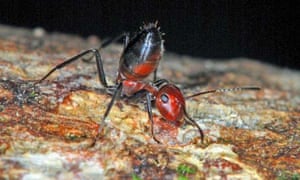Martyrdom Ants
"Amongst the countless fascinating plants and animals inhabiting the tropical rainforests of Southeast Asia, there are the spectacular 'exploding ants', a group of arboreal, canopy dwelling ants nicknamed for their unique defensive behavior."
"When threatened by other insects, minor workers can actively rupture their body wall. Apart from leading to the ants’ imminent death, the ‘explosion’ releases a sticky, toxic liquid from their enlarged glands, in order to either kill or hold off the enemy."
"They're really nice to watch in their exploding behaviour. They do it quite readily. We have some species who don't really like to explode as much."
"[They only do it in response to attack, a] form of active self-sacrifice [that kills them. The ants need to] really be provoked."
"Imagine a single ant is like a cell in a human body. The exploding workers work as immune cells, they sacrifice their lives to hold off danger."
"The explosion is not as dramatic as people think it is. [The sticky substances they exude has a] spice-like, curry-like] scent."
Alice Laciny, entomologist, Natural History Museum, Vienna, Austria
 |
| The Colobopsis explodens ant, a new species discovered in Borneo, which explodes when threatened. Photograph: Zookeys/ Alexey Kopchinskiy |
The world has an abundance of insect species, and among them are various types of ants, none perhaps as specialized as a newly discovered species of ant belonging to the group Colobopsis cylindrica, or "exploding ants". A team of researchers studied these newly-discovered ants in the jungles of South-east Asia and published their findings recently in ZooKeys, an open access scientific journal.
The colloquial name of the ants is actually "Yellow Goo". It is the researchers that named these tree-dwelling ants Colobopsis explodens. In defence mode the ant bites its enemy angling its backside as close as possible while contracting muscles so effectively its skin splits open and the sticky goo is then released. The substance functions to either kill the intruder, or interrupt its attack. It is the colony's worker bees that respond to threats or invasions of the colony, sacrificing themselves for the good of the whole.
The ants are small, with a red-brown colour. Otherwise their appearance is that of any other ant. But their bodies contain glandular sacs containing the deadly fluid. The colony's minor workers are detailed to explode when an attack threatens; expendable and reliable martyrs. Sensing danger, the ants explode, coating adversaries in the resulting toxic yellow goo, fulfilling the function for which their existence is mandated by nature.
 |
| Major worker of Colobopsis explodens with characteristically enlarged head. Image credit: Heinz Wiesbauer. |
Should an enemy manage to survive this first line of defence the colony's major workers come into play with their enlarged, plug-shaped heads characterizing them as "doorkeepers" who hasten to barricade the nest's entrance. Dr. Laciny with a group of researchers, set out in 2014 to document details of the exploding ants whose presence has been known for a century, but not much else about them. Now, through the investigative efforts of Dr. Laciny's group it is known that at least fifteen various types of these self-sacrificing ants exist.
The research group considered the newly-identified species to be "particularly prone to self-sacrifice when threatened by enemy arthropods, as well as intruding researchers". The research group nominated these newly-identified ants as their model species, serving as a reference point for future research geared to understanding more about these peculiar exploding ants.
No mention was made in their research of any similarities to the exploding ants and the cult of martyrdom with suicide-belts full of explosives now seen in use by various species of human beings.
 |
| Exploding behavior of the ant in an experimental setting with a weaver ant. (Alexey Kopchinskiy/Pensoft Publishers) |

0 Comments:
Post a Comment
<< Home